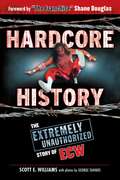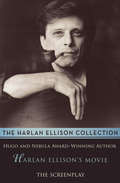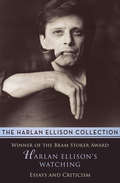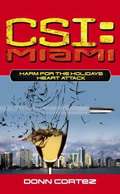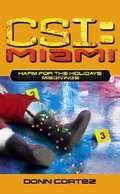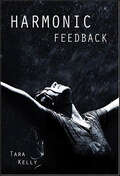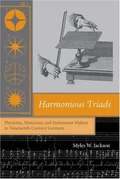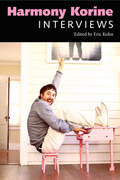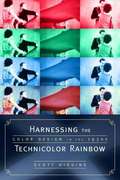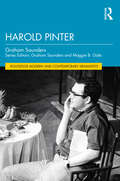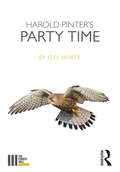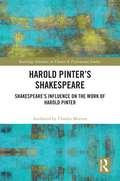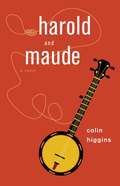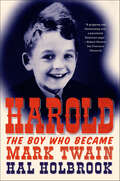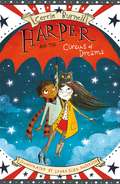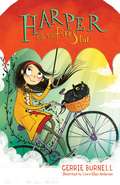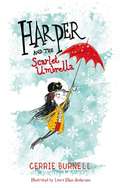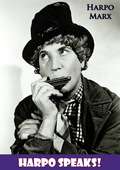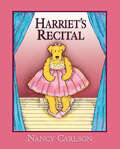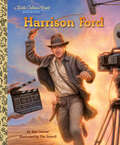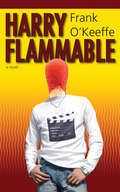- Table View
- List View
Hardcore History: The Extremely Unauthorized Story of ECW
by Scott E. Williams George Tahinos Shane DouglasExtreme Championship Wrestling (ECW) was one extreme contradiction on top of another. An incredibly influential-but never profitable-company in the world of professional wrestling in the 1990s, it portrayed itself as the ultimate in anti-authority rebellion, but its leadership was working covertly with the World Wrestling Federation and the World Championship Wrestling. Most of all, it blurred the line between reality and the fantasy world of professional wrestling.Hardcore History: The Extremely Unauthorized Story of ECW offers a frank, balanced look at the evolution of ECW starting before its early days as a Philadelphia-area independent group and extending past its death in 2001. Featuring dozens of interviews with fans, officials, business partners, and the wrestlers themselves, this is a very balanced account of this bizarre company-and it’s sure to be extremely controversial for fans and critics of ECW, and wrestling, alike.Skyhorse Publishing, as well as our Sports Publishing imprint, is proud to publish a broad range of books for readers interested in sports-books about baseball, pro football, college football, pro and college basketball, hockey, or soccer, we have a book about your sport or your team.In addition to books on popular team sports, we also publish books for a wide variety of athletes and sports enthusiasts, including books on running, cycling, horseback riding, swimming, tennis, martial arts, golf, camping, hiking, aviation, boating, and so much more. While not every title we publish becomes a New York Times bestseller or a national bestseller, we are committed to publishing books on subjects that are sometimes overlooked by other publishers and to authors whose work might not otherwise find a home.
Harlan Ellison's Movie: The Screenplay
by Harlan EllisonHerein lies in written form Harlan Ellison's Movie, the full-length feature film Ellison created when a producer at 20th Century-Fox said, "If we gave you the money, and no interference, what sort of movie would you write?" Well, that producer is no longer at the studio; he left the entire venue of moviemaking after Harlan Ellison's Movie was seen by the Suits. There is no use even trying to describe what the film is about, except to confirm the long-standing rumor that it contains a scene in which a 70-foot-tall boll weevil chews and swallows an entire farmhouse and silo on-camera. (It is Scene 33C.)
Harlan Ellison's Watching: Essays and Criticism
by Harlan EllisonOstensibly, this is a collection of Harlan Ellison's twenty-five years of essays and film criticism for various publications. What it is in reality is pure, raw, unapologetic opinion. Star Wars? "Luke Skywalker is a nerd and Darth Vader sucks runny eggs." Big Trouble in Little China? "A cheerfully blathering live-action cartoon that will give you release from the real pressures of your basically dreary lives." Despite working within the industry himself, Ellison never learned how to lie. So punches go un-pulled, the impersonal becomes personal, and the reader is left feeling like they have read something someone actually meant. It is a gauntlet, for sure, but it is also an exhilarating release.
Harm For the Holidays, Part Two: Miami)
by Donn CortezAs winter's hold deepens in the dark days of February, Miami's hotels fill to the bursting point. Cruise ships flock to the busiest port in the world as people desperate for warmer climates board these behemoths of the seas. People with too much time and money fill the clubs. In every other jurisdiction, as its citizens are driven indoors, there is a downturn in crime but not in Miami, as the members of the Miami-Dade Crime Lab can attest. Stretched to the breaking point, Lieutenant Caine is called to what appears to be a failed international terrorist incident: a botched arms-for-Afghani-heroin exchange. The scene is littered with bodies and blood droplets identified as being from one Abdus Sattar Pathan. Once before, Pathan managed to escape being charged in the murder of a Federal agent. This time Caine has him. Except Pathan has an iron-clad alibi: he was miles away, on stage doing his magic act. Horatio is convinced that Pathan and the international terrorist known as the Hare are one and the same. Can Caine prove it before the Hare puts his deadly plan into motion?
Harm for the Holidays, Part One: Miami)
by Donn CortezChristmas in Miami-the city is wrapped in its own unique festive cheer, and countless children breathlessly await the arrival of Santa Claus. Except this year there are hundreds of Santas. Miami has been invaded by the Red Menace. An annual gathering of hundreds of red-suited, jolly old fat men and women swarm over the city, comical and annoying, until one of them turns up dead. In what should be a time of goodwill to all the Miami-Dade Crime Lab finds that what appears to be the simplest of crimes hides darker motives. Who would want to kill Santa? Who would go to such lengths to conceal the identity of a victim that they would decapitate him and remove both his hands? And how does a simple convenience store robbery suddenly spiral into an international incident of kidnapping and murder?
Harmonic
by Erica O'RourkeDel's older sister can also walk between worlds, but her loyalties are uniquely tested in this original enovella set in the inventive world of Dissonance.Addison Sullivan, Del's older sister, has always been considered a model Walker--but her reputation within the Consort has been tainted by her grandfather's betrayal and her sister's recklessness. She is desperate to regain her position within the Consort and equally desperate to keep Del from spiraling out of control after losing the boy she loves. The Consort offers Addie a chance to redeem herself: if she can track down the Free Walkers her grandfather knew twenty years ago, they'll fast-track her apprenticeship and put her in charge of her own team. Addie asks a former classmate and crush, Laurel, a Consort historian, for help. As they work together, Addie's feelings for Laurel resurface, but she's too afraid to act. Same-sex relationships aren't expressly forbidden by the Consort, but she fears that a relationship with Laurel would be viewed as yet another mark against her. While she is fighting her feelings for Laurel, troubling details start emerging during their investigation...details that paint Addie's family in a sinister light. Will she reveal what she's learned to the Consort, or try to protect her family? This enovella is set in the time between Dissonance and Resonance.
Harmonic Feedback
by Tara KellySixteen-year-old, music- and sound design-obsessed Drea doesn't have friends. She has, as she's often reminded, issues. Drea's mom and a rotating band of psychiatrists have settled on "a touch of Asperger's."Having just moved to the latest in a string of new towns, Drea meets two other outsiders. And Naomi and Justin seem to actually like Drea. The three of them form a band after an impromptu, Portishead-comparison-worthy jam after school. Justin swiftly challenges not only Drea's preference for Poe over Black Lab but also her perceived inability to connect with another person. Justin, against all odds, may even like like Drea. It's obvious that Drea can't hide behind her sound equipment anymore. But just when she's found not one but two true friends, can she stand to lose one of them?Harmonic Feedback is a 2011 Bank Street - Best Children's Book of the Year.
Harmonious Triads: Physicists, Musicians, and Instrument Makers in Nineteenth-Century Germany
by Myles W. JacksonJackson analyzes the relationship of physicists, musicians, and instrument makers in Germany. Musical instruments provided physicists with experimental systems, and physicists' research led directly to improvements in musical-instrument manufacture and assisted musicians.
Harmony Korine: Interviews (Conversations with Filmmakers Series)
by Eric KohnHarmony Korine: Interviews tracks filmmaker Korine's stunning rise, fall, and rise again through his own evolving voice. Bringing together interviews collected from over two decades, this unique chronicle includes rare interviews unavailable in print for years and an extensive, new conversation recorded at the filmmaker's home in Nashville.After more than twenty years, Harmony Korine (b. 1973) remains one of the most prominent and yet subversive filmmakers in America. Ever since his entry into the independent film scene as the irrepressible prodigy who wrote the screenplay for Larry Clark's Kids in 1992, Korine has retained his stature as the ultimate cinematic provocateur. He both intelligently observes modern social milieus and simultaneously thumbs his nose at them. Now approaching middle age, and more influential than ever, Korine remains intentionally sensationalistic and ceaselessly creative.He parlayed the success of Kids into directing the dreamy portrait of neglect, Gummo, two years later. With his audacious 1999 digital video drama Julien Donkey-Boy, Korine continued to demonstrate a penchant for fusing experimental, subversive interests with lyrical narrative techniques. Surviving an early career burnout, he resurfaced with a trifecta of insightful works that built on his earlier aesthetic leanings: a surprisingly delicate rumination on identity (Mister Lonely), a gritty quasi-diary film (Trash Humpers), and a blistering portrait of American hedonism (Spring Breakers), which yielded significant commercial success. Throughout his career he has also continued as a mixed-media artist whose fields included music videos, paintings, photography, publishing, songwriting, and performance art.
Harnessing the Technicolor Rainbow: Color Design in the 1930s
by Scott HigginsLike Dorothy waking up over the rainbow in the Land of Oz, Hollywood discovered a vivid new world of color in the 1930s. The introduction of three-color Technicolor technology in 1932 gave filmmakers a powerful tool with which to guide viewers' attention, punctuate turning points, and express emotional subtext. Although many producers and filmmakers initially resisted the use of color, Technicolor designers, led by the legendary Natalie Kalmus, developed an aesthetic that complemented the classical Hollywood filmmaking style while still offering innovative novelty. By the end of the 1930s, color in film was thoroughly harnessed to narrative, and it became elegantly expressive without threatening the coherence of the film's imaginary world.
Harold Pinter (Routledge Modern and Contemporary Dramatists)
by Graham SaundersHarold Pinter provides an up-to-date analysis and reappraisal concerning the work of one of the most studied and performed dramatists in the world. Drawing extensively from The Harold Pinter Archive at the British Library as well as reviews and other critical materials, this book offers new insights into previously established views about his work. The book also analyses and reappraises specific key historical and contemporary productions, including a selection of Pinter’s most significant screenplays. In particular, this volume seeks to assess Pinter’s critical reputation and legacy since his death in 2008. These include his position as a political writer and political activist – from disassociation and neutrality on the subject until relatively late in his career when his drama sought to explicitly address questions of political dissent and torture by totalitarian regimes. The book revisits some familiar territories such as Pinter’s place as a British absurdist and the role memory plays in his work, but it also sets out to explore new territories such as Pinter’s changing attitudes towards gender in the light of #MeToo and queer politics and how in particular a play such as The Caretaker (1960) through several key productions has brought the issues of race into sharper focus. Part of the Routledge Modern and Contemporary Dramatist series, Harold Pinter provides an essential and accessible guide to the dramatists’ work.
Harold Pinter's Party Time (The Fourth Wall)
by White G. D.‘All you have do is shut up and enjoy the hospitality.’ Terry Harold Pinter’s Party Time (1991) is an extraordinary distillation of the playwright’s key concerns. Pulsing with political anger, it marks a stepping stone on Pinter’s path from iconic dramatist of existential unease to Nobel Prize-winning poet of human rights. <P><P> G. D. White situates this underrated play within a recognisably ‘Pinteresque’ landscape of ambiguous, brittle social drama while also recognising its particularity: Party Time is haunted by Augusto Pinochet’s right-wing coup against Salvador Allende’s democratically elected government in Chile. <P><P> This book considers Party Time and its confederate plays in the dual context of Pinter’s literary career and burgeoning international concern with human rights and freedom of expression, contrasting his uneasy relationship with the UK’s powerful elite with the worldwide acclaim for his dramatic eviscerations of power.
Harold Pinter's Shakespeare: Shakespeare's Influence on the Work of Harold Pinter (Routledge Advances in Theatre & Performance Studies)
by Charles MortonThis book charts the impact of Shakespeare’s works on Harold Pinter’s career as a playwright. This exploration traces Shakespeare’s influence through Pinter’s pre-theatre writings (1950-1956), to his collaboration with Sir Peter Hall (starting properly at the RSC in 1962 and continuing until 1983), and a late, unpublished screenplay for an adaptation of The Tragedy of King Lear (2000). Adding to studies of playwrights such as Samuel Beckett and James Joyce as significant influences on Harold Pinter’s work, this study aims to highlight the significant and lasting impact that Shakespeare had both formatively and performatively on the playwright’s career. Through exploring this influence, Morton gains not only a greater understanding of the shaping of Pinter’s artistic outlook and how this affected his writing, but it also sheds light on the various forms of Shakespeare’s continued influence on new writing, and what can be gained from this. This study will be of great interest to students and scholars in theatre and performance studies.
Harold and Maude
by Colin HigginsNineteen-year-old Harold Chasen is obsessed with death. He fakes suicides to shock his self-obsessed mother, drives a hearse, and attends funerals of complete strangers. Seventy-nine-year-old Maude Chardin, on the other hand, adores life. She liberates trees from city sidewalks and transplants them to the forest, paints smiles on the faces of church statues, and "borrows" cars to remind their owners that life is fleeting-- here today, gone tomorrow! A chance meeting between the two turns into a madcap, whirlwind romance, and Harold learns that life is worth living, and how to play the banjo. Harold and Maude started as Colin Higgins's master's thesis at UCLA film school before being made into the 1971 film directed by Hal Ashby. The quirky, dark comedy gained a loyal cult following, and in 1997 it was selected for inclusion on the National Film Registry at the Library of Congress. Higgins's novelization was released with the original film but has been out of print for more than thirty years. Fans who have seen the movie dozens of times will find this a valuable companion, as it gives fresh elements to watch for and answers many of the film's unresolved questions.
Harold's Circus
by Crockett Johnson"One moonlit evening, mainly to prove to himself he could do it, Harold went for a walk on a tightrope. He made sure the rope was drawn tight and straight, so it wouldn't sway. He skipped lightly across it, finding it fun to be a tightrope walker, high up over the rest of the circus. He stayed up on the rope with the greatest of ease, until he lost his balance. It also is easy to fall off a tightrope. Harold fell, twisting and turning, with his purple crayon tight in his hand. By a stroke of luck, a comfortable-looking curve appeared beneath him. And he landed on ..." "An Astounding Colossal, Purple Crayon Event!" Charming and fun.
Harold: The Boy Who Became Mark Twain
by Hal HolbrookIn Harold: The Boy Who Became Mark Twain, the beloved stage, film, and television actor Hal Holbrook presents an affecting memoir about his struggle to discover his true self, even as he learned to transform himself onstage.Abandoned by his mother and father when he was two, Holbrook and his two sisters commenced separate journeys of survival. Raised by his powerful grandfather, who died when Holbrook was twelve, he spent his childhood at boarding schools, visiting his father in an insane asylum and hoping his mother would suddenly surface in Hollywood.As World War II engulfed Europe, Holbrook began acting almost by accident. Through war, marriage, and the work of honing his craft, his fear of insanity and his fearlessness in the face of risk were channeled into discovering that the riskiest path of all—success as an actor—would be his birthright. The climb up that forbidding mountain was a lonely one. And how he achieved it—the cost to his wife and children and to his own conscience—is the dark side of the fame he would eventually earn by portraying the man his career would forever be most closely associated with: Mark Twain.“If I were to conjure an image of an individual who best fits the phrase ‘a real American,’ it would be Hal Holbrook. This book shows him as a complete person. You will be compelled by the wit and wisdom of this beautifully composed story of self-determination and survival.”—Robert Redford
Harper and the Circus of Dreams
by Laura Anderson Cerrie BurnellLate one evening as the stars begin to twinkle, Harper and her friends are flying on the scarlet umbrella when they see a girl running on air, skipping along a tightrope. She leads them to the Circus of Dreams, suspended in the air by hot air balloons. There, they meet the mermaid acrobat, the spectacular circus baker, the mysterious fortune teller and the acrobatics troupe, all more spectacular than one could dream.But as they learn more about the Circus of Dreams, Harper learns a secret about her past that is more than magic. . . .Harper and the Circus of Dreams continues the adventures of Harper and her friends in a magical mystery like no other. An enchanting story of friendship, music, and magic featuring a diverse cast, brought to life through stunning illustrations, this is a book to be shared and treasured.
Harper and the Fire Star (Harper #4)
by Laura Ellen Anderson Cerrie BurnellHarper and her friends want to help the Wild Conductor win back his place in the magical Circus of Dreams. They put on a wondrous show, but their plan goes horribly wrong. Instead of the Wild Conductor, the ringmaster selects Harper to show off her incredible musical skills for the world to see. But once inside the circus, Harper learns of the Fire Star, a girl with her own extraordinary gift. She shines like a star whenever she hears music. And Harper may have figured out why . . .
Harper and the Scarlet Umbrella (Harper Ser. #1)
by Laura Ellen Anderson Cerrie BurnellOnce there was a girl named Harper who had a rare musical gift. She heard songs on the wind, rhythms on the rain, and hope in the beat of a butterfly’s wing.Harper lives in the City of Clouds, an enchanting place where it rains every day and an umbrella is always a good idea. With her Aunt Sassy, her beloved cat, Midnight, and all of her neighbors in the Tall Apartment Block, every day is full of possibility.But when every cat in the city goes missing-including Midnight-Harper is determined to find all of the precious pets. And she’ll need a magic, flying umbrella to help in her search. Recruiting friends from her building to help, the magic umbrella whisks them into the sky on the trail of the cats and adventure.They stumble on the Midnight Orchestra-tabbies on triangle, Siamese singing, Persians on piccolo-all under the direction of its fearsome, wild conductor. But can the group use their talents, quick thinking, musical skill, and a little magic to stage a rescue like no other?Harper and the Scarlet Umbrella is a spellbinding tale of friendship, music, and magic featuring a diverse cast, brought to life through stunning illustrations. A perfect book to be shared and treasured.
Harpo Speaks!: The Autobiography (Limelight Ser.)
by Harpo Marx Rowland BarberFirst published in 1961, this is the autobiography of Harpo Marx, the silent comedian of The Marx Brothers fame.Writing of his life before, during, and after becoming famous by incorporating lovely and humorous stories and anecdotes, Harp Marx tells of growing up in a rough neighborhood and being poor, being bullied and dropping out of school, teaching himself to read, write, tell time, and to play the piano and harp.He speaks of his close relationships with his family members, particularly his mother and brother Leonard (Chico), who would become his partner-in-crime on screen, and the profound effect that the death of his parents Sam and Minnie had on him.Filled with insider tales of his antics on and off stage, and the hard graft he and his brothers put into reaching their level of success, the reader becomes privy to a rare glimpse into Marx’ thoughts on everything and everyone he had the privilege of working with.The book reveals the friendships he forged and the blows he was dealt in show-business, and of his marriage to his wife, actress Susan Fleming, with whom he adopted four children and built a ranch on which they lived happily ever after, along with numerous animals.A thoroughly enjoyable read.“This is a riotous story which is reasonably mad and as accurate as a Marx brother can make it. Despite only a year and a half of schooling, Harpo, or perhaps his collaborator, is the best writer of the Marx Brother. Highly recommended.”—Library Journal“A funny, affectionate and unpretentious autobiography done with a sharply professional assist from Rowland Barber.”—New York Times Book Review“This is a racy autobiography by the mute Marx Brother with the rolling eyes, oversized pants and red wig who could send a glissando reeling over his harp.[…] It is enjoyable reading and polished writing...”—Kirkus Review
Harriet's Recital, 2nd Edition
by Nancy CarlsonCurtains up! Harriet loves her ballet class, but when Miss Betty announces a recital, Harriet succumbs to a bad case of stage fright. She worries about falling. She's afraid her costume will rip. And she's positive that she'll forget every step of her dance as soon as she steps on stage. Young readers are sure to recognize some of their own fears in this hilarious story of Harriet's first recital.
Harrison Dwight, Ballerina and Knight (Eleanor Wyatt and Harrison Dwight)
by Rachael MacFarlaneA charming, rhyming picture book with an empowering message that challenges stereotypes from writer Rachael MacFarlane and illustrator Spencer LaudieroI heard someone once sayThat boys shouldn't cry. But boys feel things too,It’s okay, and here’s why!Equal parts humor and heart, Harrison Dwight, Ballerina and Knight follows a young boy as he cycles through various feelings he experiences in every day life. Harrison feels happiness, sadness, pride, fear, joy, anger, and courage—all while playing and imagining without limitation! With Harrison Dwight, boys everywhere will feel empowered to play in whatever way they choose and learn that it’s always okay to express what you’re feeling inside!An Imprint Book"Buoyant and inclusive... MacFarlane’s message is loud and clear." —Publishers WeeklyPraise for Eleanor Wyatt, Princess and Pirate"Eleanor Wyatt demonstrates that a girl doesn't have to limit herself to one identity... May resonate with children who don't self-identify according to societal expectations." —Kirkus Reviews"In this playful book that gently breaks down gender expectations, readers will find plenty of empowering messages encouraging creativity, individuality, and freewheeling fun." —Booklist
Harrison Ford: A Little Golden Book Biography (Little Golden Book Biographies)
by Kim OstrowGet to know Harrison Ford with this collectible Little Golden Book which tells his amazing journey from working as a carpenter to being a Hollywood star, alongside amazing full-color illustrations!Harrison decided that day to never let fear stop him from doing anything.Actor Harrison Ford has flown in a galaxy far, far away as Han Solo and has searched for lost treasures as Indiana Jones. But did you know he's just as adventurous in real life, too? Harrison flies planes and helicopters and he's passionate about protecting the environment. Harrison Ford: A Little Golden Book Biography brings his action-packed story to life. Look for more Little Golden Book biographies: • Steven Spielberg • Billy Porter • Barbra Streisand • Steve Martin • William Shatner
Harry Dean Stanton: Hollywood's Zen Rebel (Screen Classics Ser.)
by Joseph B. AtkinsThe first biography of the man Vanity Fair described as “the philosopher poet of character acting.”After a series of minor parts in forgettable westerns, Harry Dean Stanton gradually began to get film roles that showcased his laid-back acting style, appearing in Cool Hand Luke, Kelly’s Heroes, The Godfather: Part II, and Alien. He became a headliner in the eighties?starring in Wim Wenders’s moving Paris, Texas and Alex Cox’s Repo Man?but it was his extraordinary skill as a character actor that established him as a revered cult figure and kept him in demand throughout his career.Here, Joseph B. Atkins unwinds Stanton’s enigmatic persona, shedding light on his early life in West Irvine, Kentucky, and exploring his difficult relationship with his Baptist parents, his service in the Navy, and the events that inspired him to drop out of college and pursue acting. Atkins also chronicles Stanton’s early years in California, describing how he honed his craft at the renowned Pasadena Playhouse before breaking into television and movies.In addition to examining his acclaimed body of work, Atkins explores Harry Dean Stanton as a Hollywood legend, following his years rooming with Jack Nicholson, partying with David Crosby and Mama Cass, jogging with Bob Dylan, and playing poker with John Huston. Stanton is often remembered for his crowd-pleasing roles in movies like Pretty in Pink or Escape from New York, but this impassioned biography illuminates the entirety of his incredible sixty-year career, drawing on interviews with the actor’s friends, family, and colleagues.
Harry Flammable
by Frank O'KeeffeFlames follow high schooler and aspiring movie star Harry Flanagan wherever he goes. Despite a disastrous attempt at driving a bike through a burning refrigerator box in second grade, high schooler Harry Flanagan never gives up his goal of becoming a movie star or at least a stuntman. However, since the bicycle episode, it seems as if fires pop up everywhere Harry goes, earning him the infamous nickname of "Harry Flammable." Now a shed at Harry’s school has been set on fire, destroying Work Experience Counsellor Shamberg’s new mountain bike – and Harry’s charred cap was found at the scene. Harry’s dream Work Experience placement with Pocket Money Pictures is given to another student, and Harry is forced to take a position with Chef Antonio at the restaurant in The Ritz, the hotel Pocket Money Pictures’ staff is staying at while filming a historical adventure flick set in China. Will Harry find a new way into the movie of his dreams, or will he be forced to endure a placement he hates and an inevitable kitchen fire … or two?
